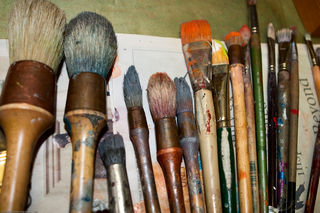Television's once 'vast wasteland' is being supplanted by an exponentially expanding variety of new shows and formats. Rather than being killed off by ebooks, print editions are coming back, as are the independent bookstores that nurtured them.
These two examples illustrate the ways in which technology has been adopted by - and has adapted to - the demand for greater creativity in thought and deed. The reasons have to do with relative rises in education and communication among a diverse array of individuals and broader populations whose cultural, social and economic diversity is exposing ideas, theories, arguments, biases and passions to others who might not otherwise have ever heard, watched or seen them. The result is a ferment which is stimulating rather than suppressing the creative impulses that lead to innovation in thought and action across the socio-economic spectrum.
The challenge is that keeping those impulses flowing, however disruptive and uncomfortable they may sometimes be, requires support, protection, tolerance and investment at the social, institutional and individual level so that the fruits of this revolution may continue to flow. JL
Laura Otis reports in Psychology Today:
Thinking that people stare at their smartphones because they’re interested in phones is like thinking that scientists study Drosophila genetics because they’re interested in fruit-flies. Artists have to learn the rules of their domains before they can break them, and their innovations must be accepted as valuable by experts in their fields. Creativity must be nourished and challenged, and it thrives because of cultures and technologies, not in spite of them.
In a Berlin museum, a guard called my attention to a special picture. People were streaming in to see the Spanish Siglo de Oro exhibit, but few were studying the museum’s glorious collection, and he and I stood alone in a room of 15th-century Flemish paintings. The one he loved portrayed an old man wearing a thin stole of fox-fur. “Look at the fur,” he said. The little-known artist had painted it in such detail, it looked as though it would tickle my cheek. With infinitely fine lines, he had turned a two-dimensional surface into an illusion of floating softness.
The guard and I spoke about how long the artist must have studied to learn his technique. He must have started as an apprentice, cleaning brushes, and at some point he would have been allowed to paint feet. Only after decades of observation and practice could he have become a master.
As psychologists such as Mark Freeman and Mihaly Csikszentmihalyi have shown, no one becomes an artistic genius alone (Freeman 1993; Csikszentmihalyi 1996). Popular myths depict artists as rebels who succeed despite social forces, but that is not what the data show. Artists have to learn the rules of their domains before they can break them, and their innovations must be accepted as valuable by experts in their fields (Csikszenhimihalyi 1996, 27). As Freeman’s interviews with artists have revealed, “It is not quite right to say that creativity is affected by social conditions. Instead, it would seem more appropriate to say that creativity is constituted through those conditions” (Freeman 1993, 12). The painter of the fox-fur had talent, and he probably wanted to create art. But that talent would never have bloomed into brilliance without the apprenticeship his Flemish culture allowed.Source: See-ming Lee, Artist Studio: James Cospito, Brooklyn Art Project HQ. Image source: Flickr.com
The museum guard wanted to discuss more than painting, and I shrank when he spoke of young people’s unwillingness to work. According to a friend of his who taught high school, only three in a hundred students nowadays want to learn. The others are all playing with their smart phones. For a minute I empathized with him. I turned 55 yesterday, and I know the frustration of dodging zombies who walk staring into palm-sized boxes and expect the world to make way for them. What do they see that’s more fascinating than the people around them and the sky above? But my students with smart phones are brilliant, and no one could work harder than they. If young people who won’t learn constitute a threat, what about old people who won't learn?
I told the guard that people could be creative with smart phones, an idea he didn’t accept. The marvelously daring film Tangerine was shot on an iPhone, and one can be active or passive with digital technology just as one can be active or passive with a pen and paper. Thinking that people stare at their smartphones because they’re interested in phones is like thinking that scientists study Drosophila genetics because they’re interested in fruit-flies. Digital devices offer views into the way the world works, and they invite rather than stifle creativity.Source: Image source: Pexels.com
With all the warnings about what digital technology is doing to human brains, there has been less talk about what we’ve gained from it. If one thinks of a creator as a bounded individual, artistry remains more limited than if one thinks of human-machine networks or creative groups. The painting the museum guard admired emerged as the work of partnerships and tools: the person who cooked the artist’s meals; the person who taught him to paint; and the brushes, pigments, and canvas that constituted the technology of his time.
Creativity must be nourished and challenged, and it thrives because of cultures and technologies, not in spite of them. “The basis of art is truth,” said fiction-writer Flannery O’Connor, and it takes courage, patience, and overwhelming work to render truth in a form that engages many people (O’Connor 65). I regard it as equally courageous to shoot a feature-length film on an iPhone and to spend months painting fox-hairs so that a viewer can imagine them against her skin. As artistic creators, Tangerine director and co-producer Sean Baker and the 15th-century Flemish painter might not be as different as they seem. By studying the works of artists they admired and finding the support they needed, both created works that make their viewers feel. I left the museum guard alone with his painting, an old man contemplating an old man, hoping that artists born today would have the perseverance to create such beauty.






















0 comments:
Post a Comment